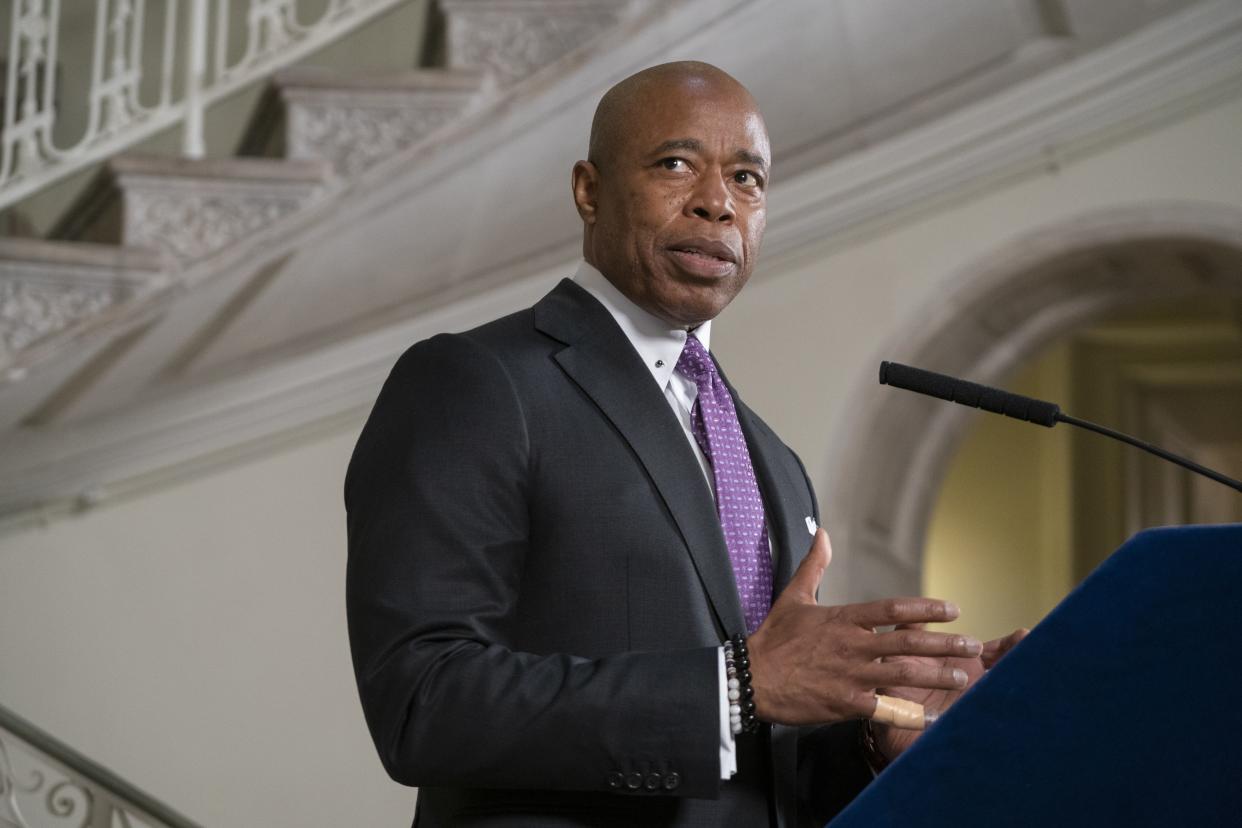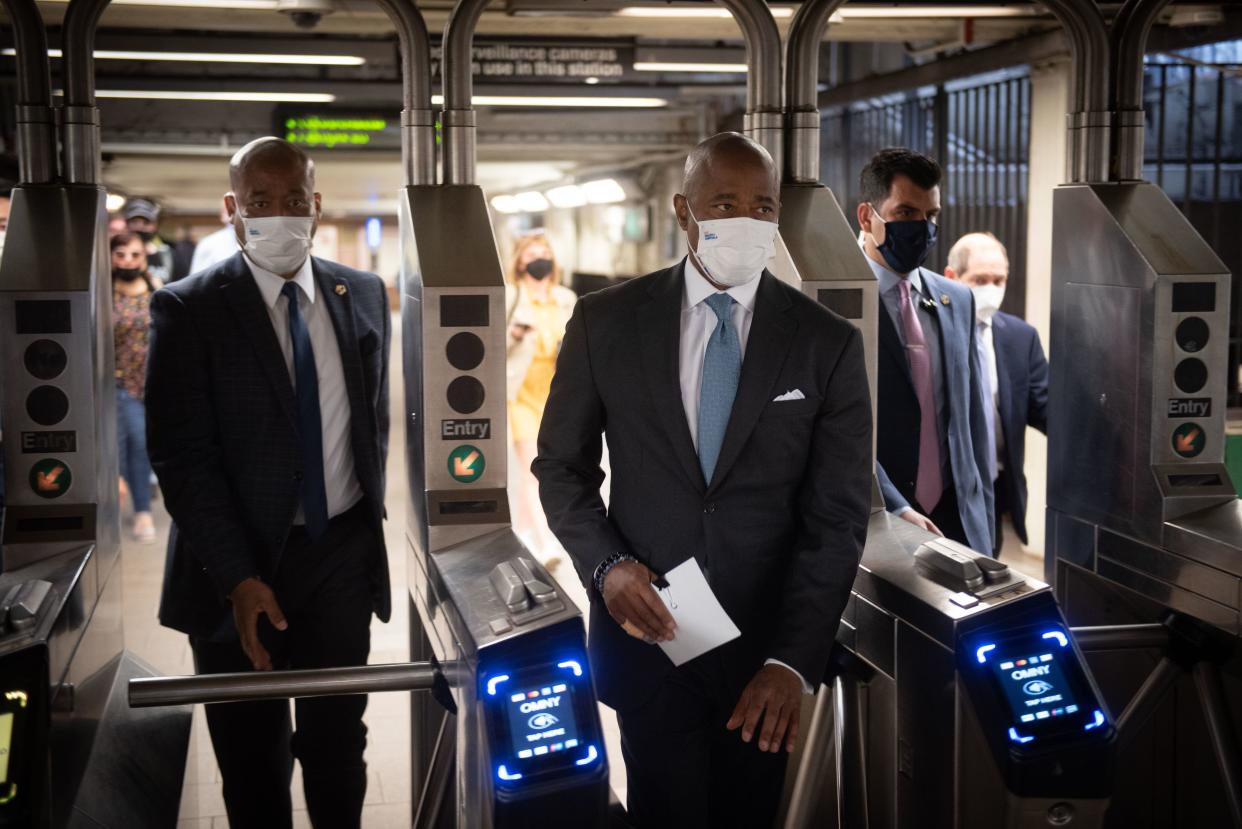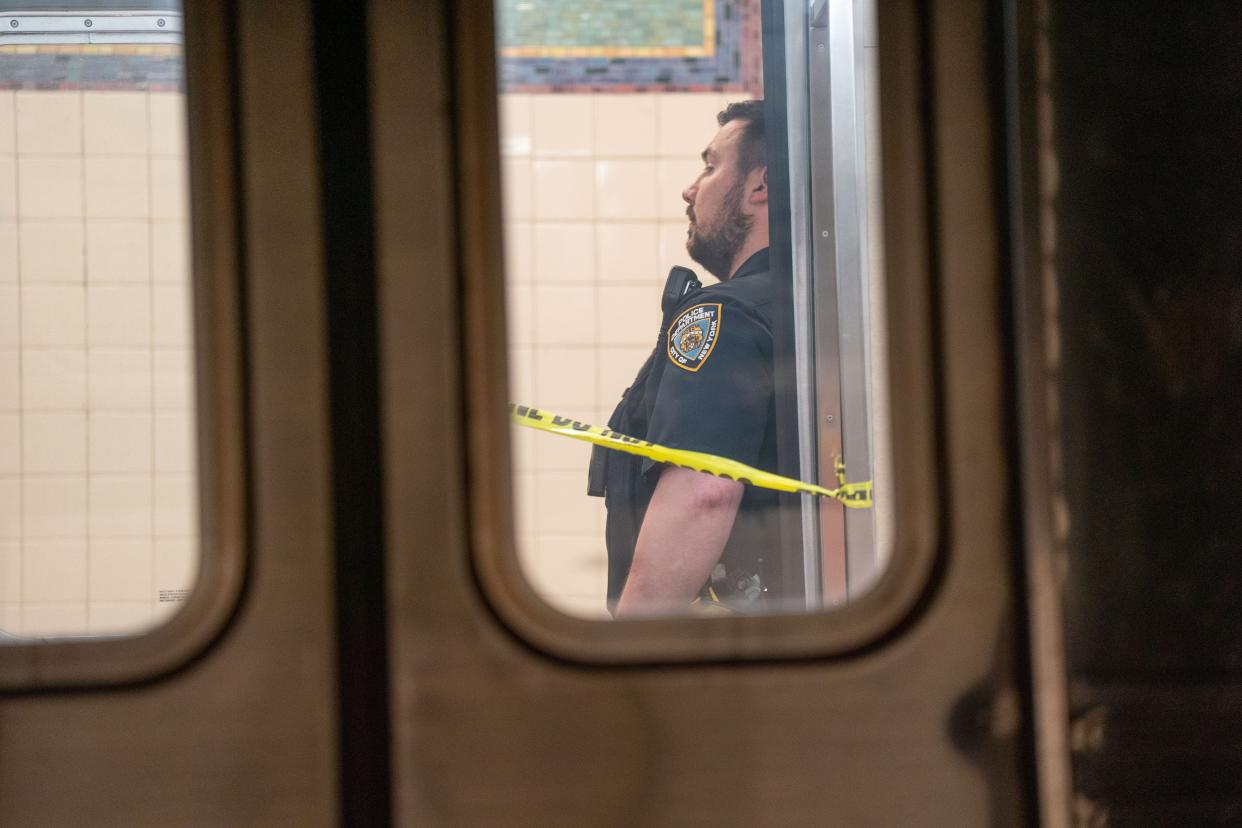Lethal shooting on train keeps fear of NYC subways on front burner for riders, Mayor Adams and local economy
The subway shooting that left a Goldman Sachs employee dead on Sunday has led to a shockwave of fear among workers on the fence about returning to their jobs in person, but Mayor Adams suggested Tuesday that the same level of trepidation has been in the air on city subways since last year.
By his telling, business leaders have been saying the same thing since before he took office — that their employees have been, and still are, afraid to ride the rails.
“They are saying the same things,” Adams said of the business leaders he’s spoken with. “Their employees are concerned about the safety on the subway system.”

New York City Mayor Eric Adams takes questions from the media at City Hall in lower Manhattan, New York on Thursday, May 19, 2022. (Barry Williams/)
Adams was recounting how he began building relationships with business leaders and small-business owners before being sworn in as mayor. In the time since then, he said he’s kept them apprised as the situation on the subways continues to evolve, updating them on his policies to deploy more cops and to remove homeless encampments from the system.
“We want to give them information, keep them informed on what we’re doing, and really just have an open dialogue with our companies,” he said.
NYC poll finds 86% want more cops in subways; 61% fear riding trains at night
And while his side of that dialogue has changed with each policy update, the response he’s hearing has remained by and large the same: Workers are still scared.
“We are addressing that every day. Gun arrests have gone up. Homicides have gone down. Shootings have gone down,” he said. “You are starting to see the implementation of what we are attempting to do.”
On the subways, though, the statistics tell a different story.

New York City Mayor Eric Adams rides the subway from Harlem to City Hall in Manhattan, New York on Monday, May 23, 2022.
Through Sunday, crime in the subway is up 58%. Fifteen people have been shot in the transit system so far this year, including 10 during the shooting in Sunset Park that resulted in the arrest of Frank James.
The latest victim was Daniel Enriquez, a Goldman Sachs researcher gunned down on the Q train by a stranger. The suspect in the shooting, Andrew Abdullah, turned himself in on Tuesday.
By this time last year, only two people had been shot in the subway, compared with the 15 this year.
NYPD chiefs will walk a beat on city subways amid crime spike
The spike in gunplay underground comes at an inopportune time for Adams, who’s made getting people back to work in person an emphasis of his first five months in office. On Tuesday, he and Gov. Hochul launched a blue-ribbon panel to examine the future of the city and the region’s economy.
The response Adams is getting from business leaders about the rash of violence might be similar to what he was hearing in January and February. But business leaders and straphangers who spoke to the Daily News on Tuesday said the killing of Enriquez has hit differently.
Ralph Esposito, regional president for the Suffolk Construction Co., said Sunday’s shooting exacerbated unease among his employees already concerned due to attacks in the subway.
Suffolk, which has an office in the Garment District, is requiring employees to report to work in-person five days a week with accommodations for those who test positive for COVID-19 or whose family members are infected.
Goldman Sachs, where Enriquez worked, is also now requiring its employees to be back in the office five days a week, according to a company spokeswoman.

NYPD on the scene after the fatal shooting of Daniel Enriquez on the Manhattan-bound Q Train at the Centre Street/Canal Street Station in Manhattan, New York on Sunday, May 22, 2022. (Theodore Parisienne/)
”Most of us rely on the subway, and people are genuinely concerned about their safety,” said Esposito. “The No. 1 thing that our employees are concerned about at the moment is safety, not COVID.”
As a result, Esposito said Suffolk’s management has instructed employees to consider how they commute to work.
”We tell people to try to use mass transit when there’s a lot of people, and that if they have to go home late at night, we encourage them to take an Uber,” he said.
Andrew Rigie, executive director of the New York Hospitality Alliance, said the restaurants and bars his group represents have much more cause for concern than white-collar workers — many of whom can still work from home.
Plus, more workers staying home translates to fewer of them patronizing bars and restaurants in the city’s business nodes.
“If someone doesn’t feel safe traveling into the city, they’re not going to be buying lunch at a local restaurant or go to bars for happy hour,” Rigie said. “People are recognizing how quickly public perception can change and the impact it has on the industry, and it’s a conversation that’s front and center right now.”
Carlo Scissura, who was in line to become Adams’ economic development czar earlier this year but ultimately didn’t amid concerns over his past lobbying work, said Sunday’s shooting hampered the push toward office employees getting back to in-person work full time.
“The momentum was growing, and then Sunday happened and now people just need a bit to catch their breath,” said Scissura, who’s the president of the Building Congress, which represents hundreds of companies in the real estate industry. “Maybe it will take a week or two.”
The Durst Organization, one of the city’s largest purveyors of office space, shared data with The News showing that New York City white-collar employees have returned to in-person work at an increasing rate this year.
Over the past six weeks, occupancy rates in the 13 million square feet of office space that Durst manages in the city have been at around 50% of prepandemic levels on Mondays; 60-65% on Tuesdays, Wednesdays and Thursdays; and 40% on Fridays, the data show.
“That’s much, much higher than a year ago,” said Jordan Barowitz, vice president of public affairs at Durst.
Meantime, not everyone blamed random acts of violence for people’s reluctance to come back to the office.
“I’ve lived in New York for 12 years. A lot of bad things have happened; you can’t live your life in fear,” said Ciera Lowe, 29, who commutes on the subway from downtown Brooklyn to her job in IT at the World Trade Center. “I work in data. When you look at crime, the shooting, and you look at per capita statistics, it’s really not that scary.”
Vivek Agar, who works in the Financial District and takes the PATH from New Jersey, said he and his co-workers come in two days a week, not close to full occupancy. He estimated it’s about 20% full on any given day.
“People have gotten used to working at home. Some people I work with are concerned about crime, but I think some people are using it as an excuse to keep working remotely,” he said. “New York is not the same. The energy you used to feel is not there. I don’t know when it will come back.”
With Rocco Parascandola
